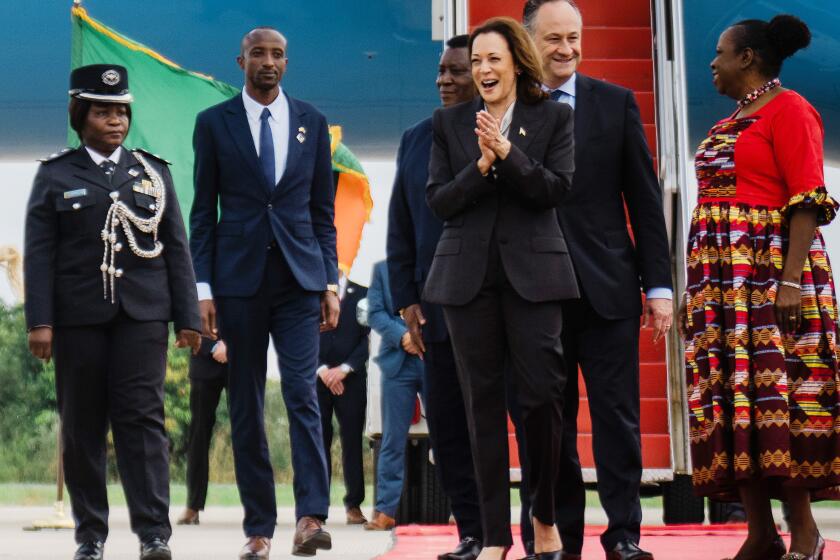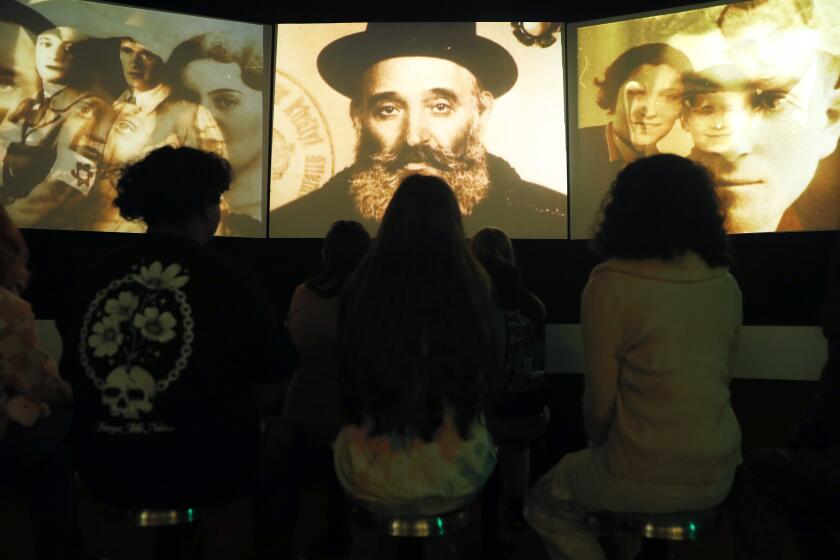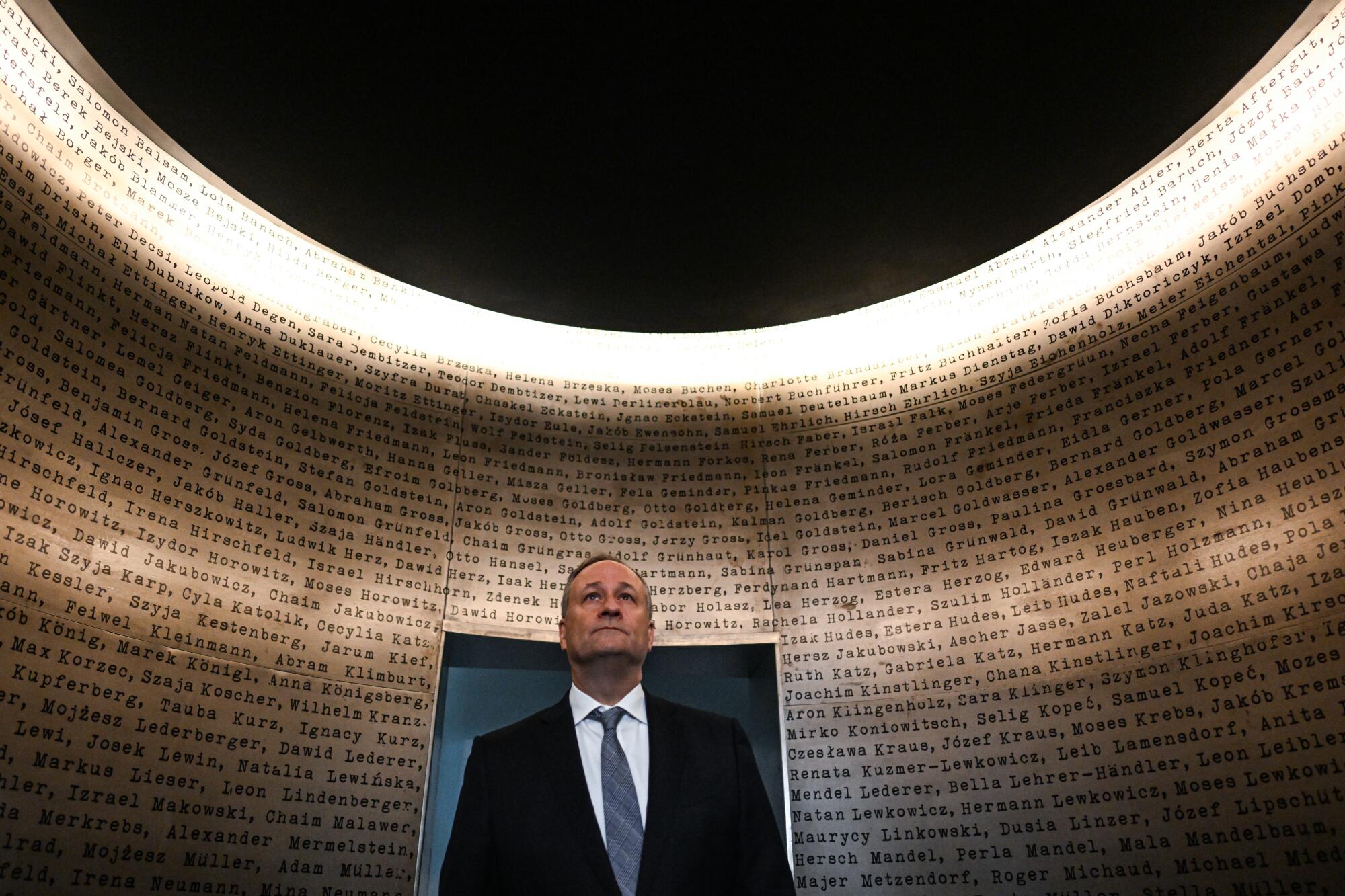
- Share via
WASHINGTON — Second Gentleman Doug Emhoff was furious.
Kanye West, now known as Ye, had spent weeks giving Americans a crash course in antisemitic lies. He posted on Instagram that the rapper Diddy was being “controlled” by Jews. He tweeted that he planned to go “death con 3 on Jewish people.” He told Piers Morgan he was “absolutely not” sorry.
Then, on Oct. 22, members of an antisemitic group in Emhoff’s hometown of L.A. extended their right arms in the Nazi salute and unfurled a banner over the 405 Freeway that read “Kanye is right about the Jews.”
Emhoff, the first Jewish spouse of a president or vice president, knew he had to act.
“When it’s happening in my city, in my neighborhood, on my freeway, it makes it really personal,” he told The Times.
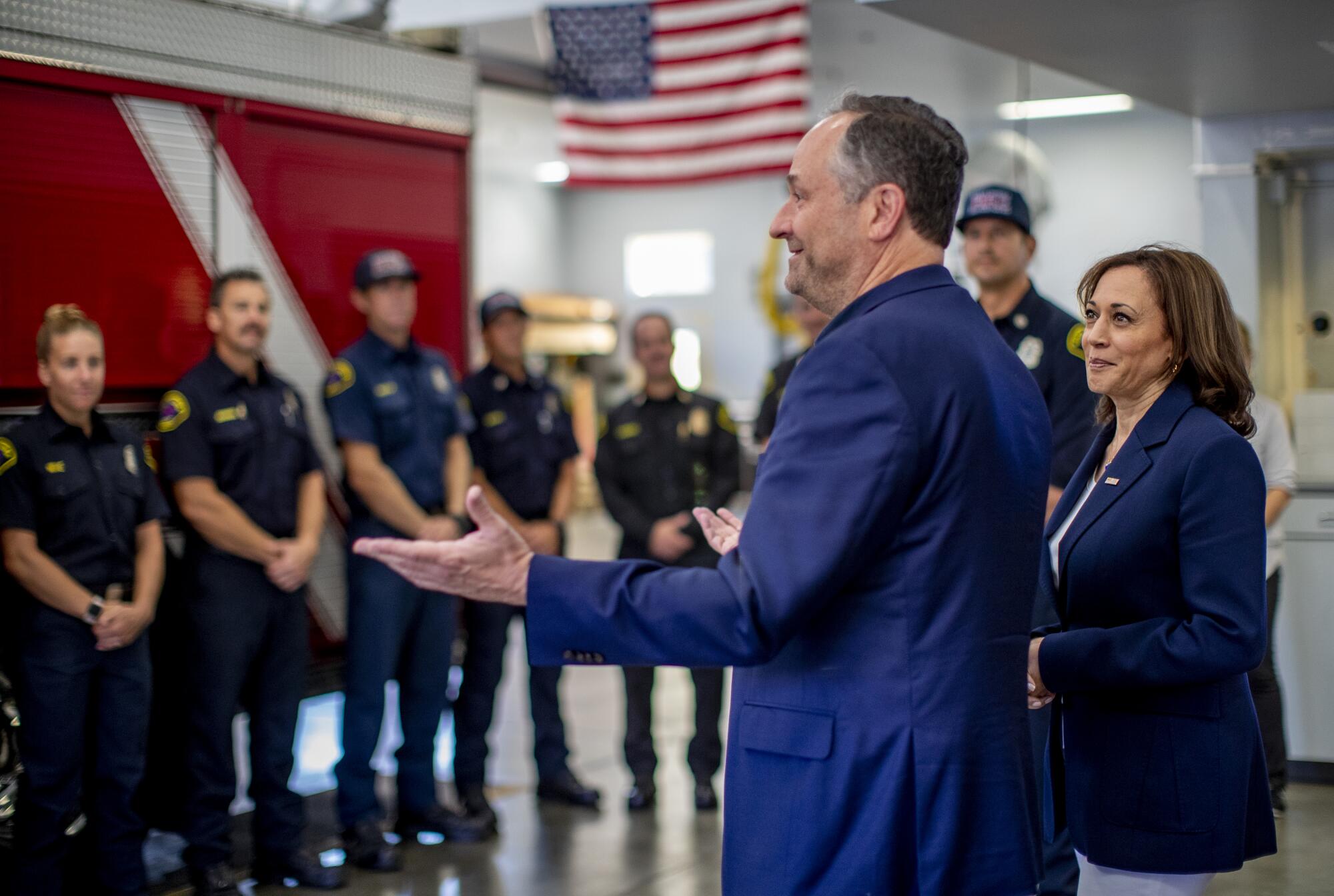
In the two years since becoming the United States’ first second gentleman, Emhoff, 58, has become an emissary for his trailblazing wife, Vice President Kamala Harris, crisscrossing the country to push COVID-19 vaccines and traveling to Tokyo to represent the U.S. at the Paralympics. A former entertainment lawyer, he initially intended to focus his attention on gender equity and access to legal services.
The vice president is more comfortable than ever exploring her family history. But there’s a reason she’d rather talk about California than India, Jamaica or Zambia.
But as he settled into his new life in Washington, Emhoff found the accidental spotlight. No longer just a supporting character for his barrier-breaking wife, Emhoff emerged as an ambassador for his faith and heritage.
He had highlighted his identity in obvious ways: He lit the first candle at the National Menorah lighting ceremony to mark the start of Hanukkah, visited synagogues (including his own childhood temple in New Jersey) and in March 2021 held the White House’s first virtual, open-to-the-public Passover Seder for thousands of Jews who were paying attention to how the White House celebrated. And he had displayed his Jewishness in more personal moments: making matzo-ball soup with children at a Washington-area school and visiting a Holocaust museum while his wife held diplomatic meetings in Paris.

Subscribers get exclusive access to this story
We’re offering L.A. Times subscribers special access to our best journalism. Thank you for your support.
Explore more Subscriber Exclusive content.
But West’s comments — and, soon after, former President Trump’s decision to host the rapper at Mar-a-Lago — required a different sort of response.
In the years since neo-Nazis marched in 2017 in Charlottesville, Va., chanting, “Jews will not replace us,” antisemitic attacks had increased across the U.S. Now one of the most famous musical artists on the planet was elevating the very worst antisemitic tropes, and the former president was giving him a platform to do more of it.
Harris encouraged her husband to be more forceful. Emhoff, White House officials decided, would have to evolve from candle-lighter and matzo-maker to the administration’s chief voice against antisemitism.
Sitting across from aides in November in his office, Emhoff asked how he could be more effective. He had penned an op-ed for USA Today for Rosh Hashana in September, vowing to combat hate toward Jews, and was planning to convene government officials, rabbis and Jewish leaders to discuss extremism in December.
He and the aides agreed that op-eds and roundtables would not suffice.
Emhoff began preparing for his biggest challenge yet: a trip to Poland and Germany with Deborah Lipstadt, a Holocaust scholar who serves as the U.S. special envoy to monitor and combat antisemitism.
On the schedule: Marking International Holocaust Remembrance Day, visiting Auschwitz and confronting the fate his ancestors had escaped.
In trusting Emhoff with the fraught mission to Eastern Europe, Harris and President Biden were pushing him into a new role. He would have to prove that he could use his new platform in a way that felt authentic — and hope, as he always does, that his actions would boost his wife’s chances of becoming the next Democratic president.
“This issue found you,” Harris told Emhoff before he set off on his trip. “And now you need to be up to the task.”
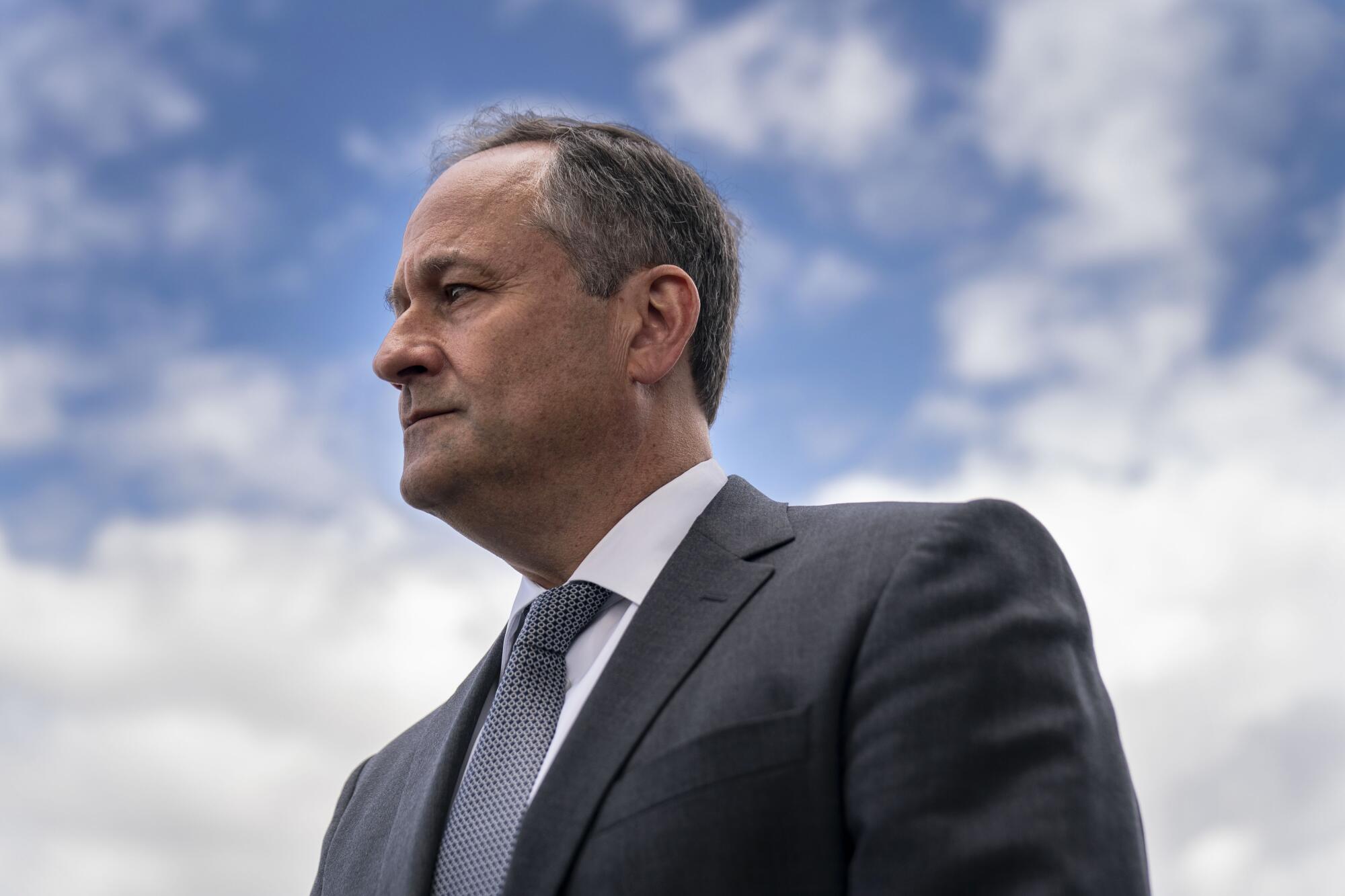
The policy role was important, of course, said Halie Soifer, a former Harris aide who is now chief executive officer of the Jewish Democratic Council of America, “but it’s the way that he got there that’s perhaps the most interesting.”
For the record:
8:59 a.m. April 11, 2023An earlier version of this article incorrectly stated that Second Gentleman Doug Emhoff’s daughter, Ella, is 24. She is 23. The article also incorrectly stated that Emhoff was 17 when he moved to California. He was 16. The family relocated to Westlake Village, not Agoura Hills, as previously stated.
Emhoff came to Washington by way of Southern California. His father, a designer of women’s shoes, moved the family from suburban New Jersey to Westlake Village, a bedroom community of Los Angeles, in February 1981, halfway through Emhoff’s junior year of high school. A 16-year-old Emhoff, his curly hair carefully coiffed, felt like he had been dropped into the movie “Fast Times at Ridgemont High.” He loved it.
The Emhoffs were not deeply religious, but Doug had a bar mitzvah — he frequently recalls the brown velour suit he wore, as well as the summers he spent playing tennis and soccer at Camp Cedar Lake, a Jewish camp in Milford, Pa. He regales donor crowds with Passover tales of his grandmother’s “dry brisket” and his unironic love of gefilte fish, and casually refers to Biden as a “menschy dude.”
After earning his undergraduate degree from Cal State Northridge in 1987 and a law degree from USC in 1990, Emhoff rose to prominence as an entertainment lawyer.
First at his own firm, and later at Big Law giants Venable and DLA Piper, he handled high-profile clients including pharmaceutical company Merck and arms dealer Dolarian Capital. He enjoyed long lunches out of the office, playing golf (a sport he misses) at Hillcrest, a historically Jewish country club, and dinner at Westside haunts Toscana and Craig’s.
Today, Emhoff identifies with Reform Judaism, a liberal denomination that is the largest in the U.S. He doesn’t belong to a synagogue but has maintained a foothold in the L.A. Jewish community since the 1990s, when he began volunteering for Bet Tzedek, a pro bono legal services organization founded on Jewish values.
“We didn’t meet in temple,” said Mitch Kamin, an L.A.-based lawyer and friend who got to know Emhoff through Bet Tzedek. “He’s a West L.A. Jewish lawyer who is involved with his community and, you know, goes to services, but not, like, every Friday. … It’s part of his family and his culture and his upbringing.”
Emhoff was a single, divorced father of two when he met Harris in 2013. (His children — Cole, 28, and Ella, 23 — are named for the jazz icons John Coltrane and Ella Fitzgerald.)
The couple married the next year at the Santa Barbara Courthouse in a family ceremony officiated by Harris’ sister and closest political advisor, Maya. The union symbolized the shifting demographics of the United States: Harris, a Black and South Asian American, placed a flower garland around Emhoff’s neck, in a nod to her Indian heritage, while he, in Jewish tradition, stomped on a glass.
The couple continued to live a “normal-ish life,” Emhoff told a group of students last May, while Harris served as California’s attorney general and, later, a U.S. senator.
Emhoff’s Jewish identity was evolving, too, becoming an important component of the couple’s public life. In mid-November 2017, Harris invited her husband to join her on her first congressional delegation to Jerusalem.
Between events in Beersheba and at a water desalination plant, the freshman senator set aside time for Shabbat dinner, a visit to Yad Vashem and fulfilling a Jewish rite of passage for her husband’s first trip to Israel. The sun was setting as Harris and Emhoff drove to Jerusalem’s Old City, where a steady stream of worshipers trickled onto the Kotel Plaza to pray at the Western Wall.
As they approached the Kotel, Harris paused to place a kippa on Emhoff’s head. He bent over to allow his 5-foot-2 wife to fasten it with a clip. The couple smiled as she positioned it in place; Emhoff flushed with pride and laughed. He cherished the unscripted moment in a trip that was otherwise planned to the minute.
The spike in antisemitism and other hate crimes in L.A. is grim, but a Jewish neighborhood in L.A. offers glimmers of hope.
A quintessential Angeleno who relished life adjacent to the spotlight, Emhoff had to “get used to a new kind of scrutiny” when Harris launched her fleeting presidential bid, she wrote later. Although most political spouses lament the constraints of public life, many have years to adjust to it. For Emhoff, the change came almost overnight. In a matter of months, he went from a behind-the-scenes deal-maker to a Democratic surrogate and Harris’ most effective fundraiser.
But Emhoff also realized that his identity — and how he communicates it to the public — could be a political asset. Despite years of effort by Republicans, about 7 in 10 American Jews are Democrats, many of them liberal. (Orthodox Jews, who overwhelmingly identify as Republican, are the exception.)
Emhoff “is smart enough to know that everything he does has a political dimension to it,” said Alan Solow, a former chairman of the Conference of Presidents of Major American Jewish Organizations who helped Emhoff raise money for Harris. “But I think he’s smart enough to know that it doesn’t help her to be someone other than who he really is.”
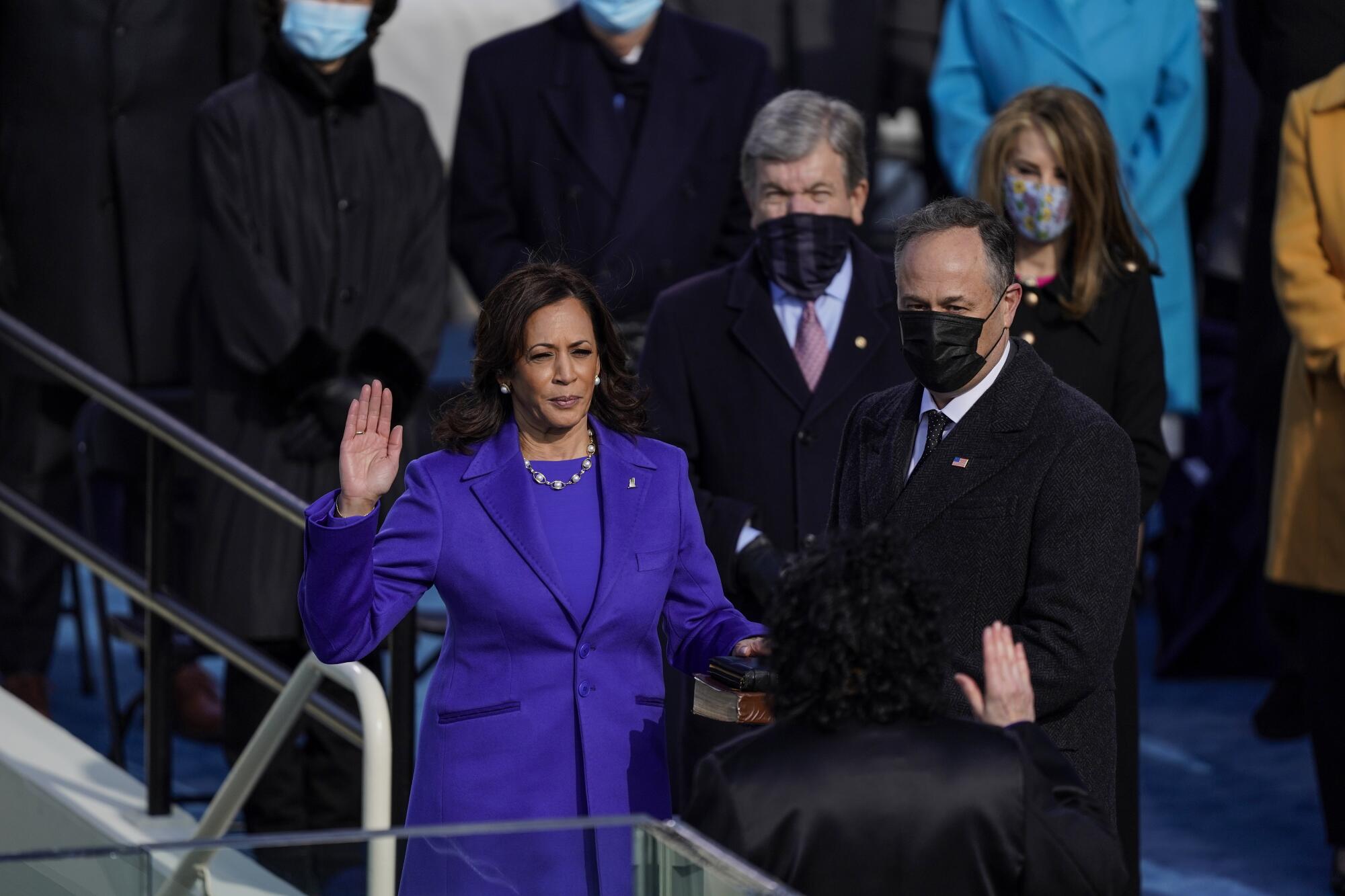
In January 2021, Harris was inaugurated, and the couple moved into the Naval Observatory, the vice president’s traditional residence. That October, with Harris and his parents peering over his shoulder, Emhoff hammered a mezuza, a decorative case containing a small parchment scroll inscribed with a prayer, into the right-hand side of the Observatory’s wooden doorpost. The private ceremony marked the first time the Jewish sign of sanctity was hung in the entryway of an executive home.
Some observers hailed the election of Biden, who has said that seeing neo-Nazis march in Charlottesville spurred him to run, as a rebuke of the bigotry and extremism that flourished under Trump. But hate crimes in the U.S. continued to rise after Biden and Harris took office. Antisemitic incidents in the U.S. surged 36% in 2022, reaching the highest level recorded since 1979, according to the Anti-Defamation League. The number of incidents in Los Angeles, Riverside, San Bernardino and Kern counties jumped 30% compared with the previous year.
The Anti-Defamation League said there was a 41% increase antisemitic incidents in California. Nearly half of the state’s 518 incidents were in L.A., Riverside, San Bernardino and Kern counties.
By the time Emhoff saw the first photos of the banner over the 405, American Jews were already enduring a spike in harassment and assaults. The second gentleman “seized the opportunity” to act “because, as he’s said, it’s important to live openly and proudly as Jews,” said Emhoff’s friend Ted Deutch, a former Democratic member of Congress from Florida. “It’s important to live freely without fear.”
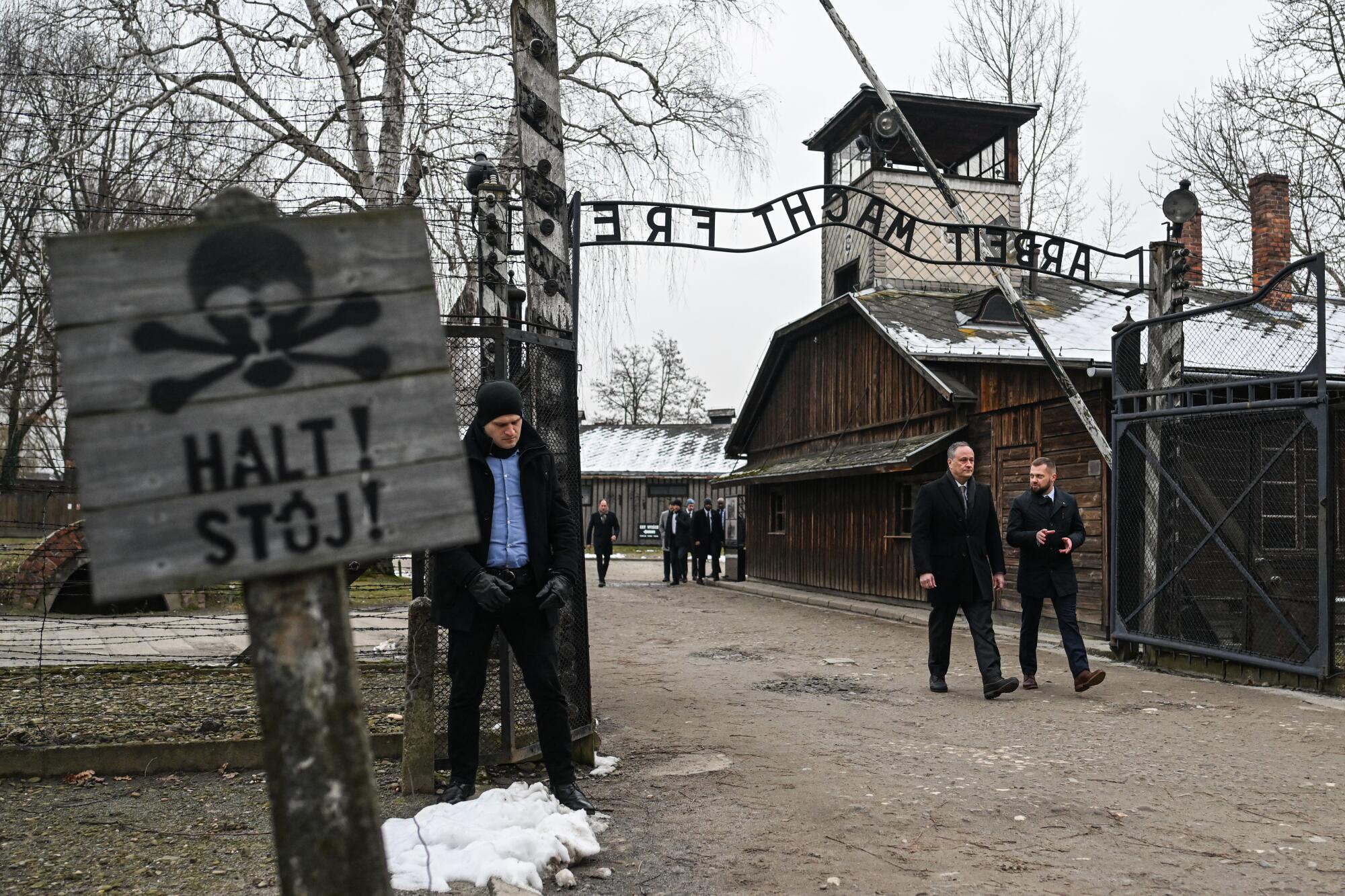
Two weeks before Emhoff set off for Eastern Europe, Biden pulled him into the Oval Office.
The president recalled talking about the horrors of the Holocaust with his father and how angry the elder Biden was that the Allies had not bombed the train tracks leading to the concentration camps. Biden told Emhoff he had visited the Dachau concentration camp in southern Germany with his children and grandchildren.
Emhoff’s trip, Biden said, was personal for him, and he wanted the second gentleman to use his voice on the world stage.
The trip was crammed with historical — sometimes emotionally draining — stops. Emhoff met with Ukrainian refugees. He toured Oskar Schindler’s factory. He walked Berlin’s cobblestone streets, which gleamed with Stolpersteine, or “stumbling stones,” 4-inch concrete blocks with brass plates inscribed with names of people murdered by the Nazis. In freezing rain, he visited Berlin’s Holocaust memorials, spread across a few blocks near the Tiergarten and Brandenburg Gate, and placed a rose or wreath at each.
As the spouse of the vice president, Emhoff often has the privilege of avoiding tough questions on polarizing issues. But as many Jewish American politicians discover, often to their discomfort, talking about antisemitism can lead to questions on more controversial topics.
On Emhoff’s first night in Krakow, Poland, a Palestinian gunman shot and killed seven people near a synagogue in Jerusalem, sending press aides scrambling to prepare the second gentleman to carefully respond to questions about the attack. As expected, he denounced the violence.
But as his public role grows, activists, political operatives, journalists and the public will ask him to take positions on more issues.
Emhoff’s cheerleading for refugees fleeing war in Ukraine fits awkwardly with the Biden-Harris administration’s efforts to limit access to asylum in the U.S. Some in the White House have pressed Emhoff to be more publicly unequivocal about his (and the administration’s) support for Israel, just as some outside the White House would like him to be more critical of Benjamin Netanyahu’s government. Even the issue of antisemitism itself is adjacent to more fraught arguments: Most people hate Nazis; not everyone endorses punching them.
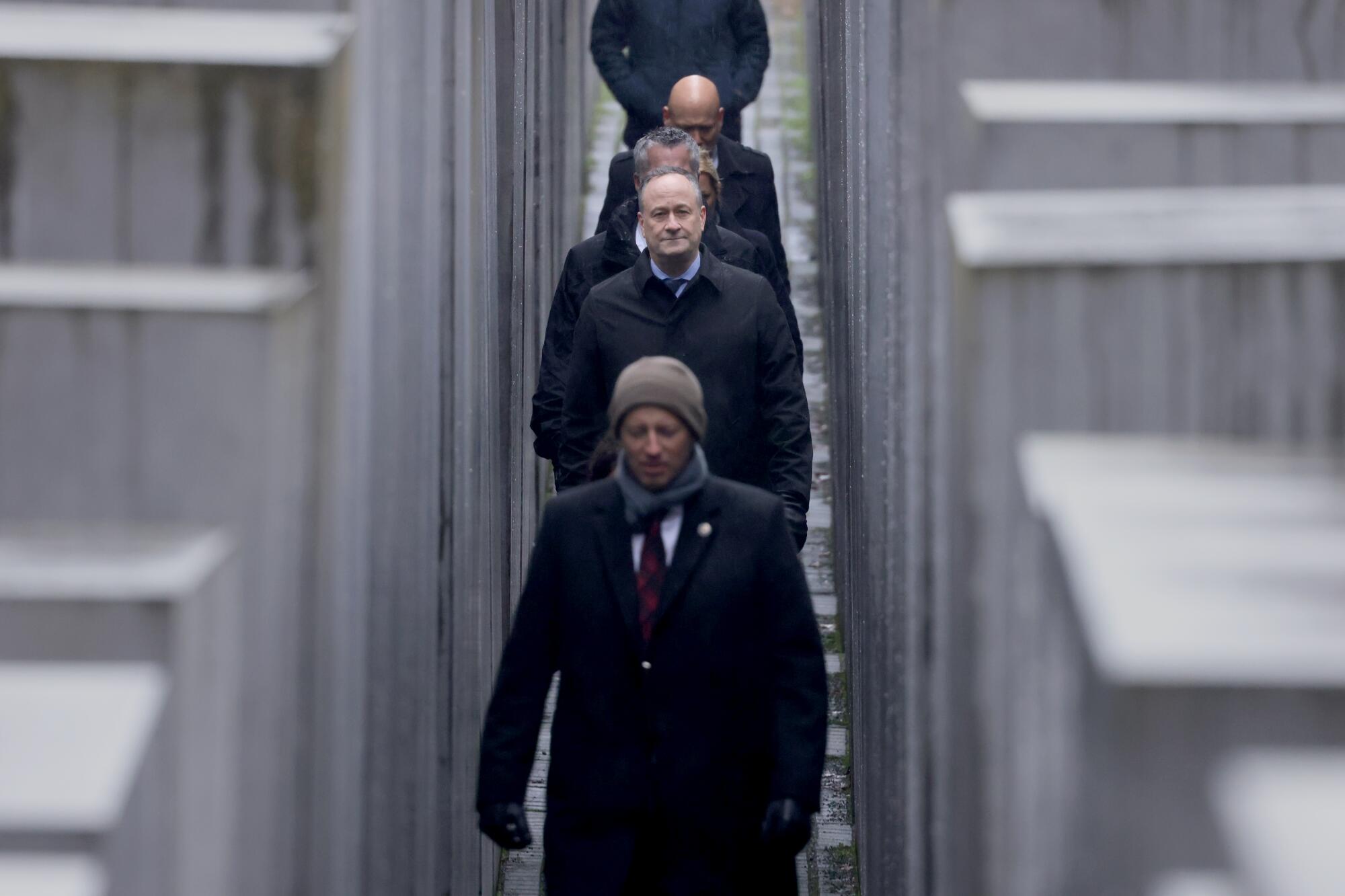
Keeping Emhoff in a public-facing role demonstrates the administration’s confidence that he can speak on many issues with authenticity, Soifer argued.
“He would not [have gone] on this trip if it were not for her role now as vice president,” she said. “But, at the same time, he is very authentically and naturally defining his own role and his own voice, and there’s great significance to that for the Jewish community.”
The greatest test of Emhoff’s ability to serve as an authentic representative of American Jews came on his visit to Auschwitz-Birkenau, the death camp complex where the Nazis murdered around 1.1 million people, including 960,000 Jews.
He had good reason to visit.
“This is a Jew who would have been incinerated in the crematorium and is now the second gentleman of the United States,” said Rabbi Sharon Brous, who led the Seder dinner Harris and Emhoff hosted. The sight of him at Auschwitz, she argued, would send “a very hopeful message from one of the darkest and most awful places in the world.”
But Auschwitz is difficult enough to process on your own; Emhoff, who arrived on the 78th anniversary of its liberation, had to move through it with cameras trained on his every expression.
“You’re almost not human if you don’t feel emotion there,” he said. “It’s a very vulnerable feeling to experience something that emotional and personal with everyone watching. This issue is so raw and important to me as an American Jew. … I’ve got to get this right, and I’m working really hard to do that.”
Snow flurries fell on his black overcoat as he approached the camp’s infamous entrance gate, which bears the phrase “Arbeit Macht Frei,” or “Work makes you free.”
He walked through the camp as the temperature plunged, stepping inside a crematorium where thousands of Jews perished and placing a flickering oil lamp at the edge of a memorial.
In a courtyard between two empty barracks, he wiped away tears as he placed a wreath of red, white and blue flowers in front of a wall where thousands of prisoners were executed.
Cameras flashed; MSNBC was filming.
Emhoff thought of the thousands of Jews back home — including his own parents — who would watch the ceremony on television or the internet and experience this painful moment through him.
He was going to do his best.
Donning a kippa, he bowed his head and tugged at the wreath’s ribbons, which read, “From the people of the United States.”
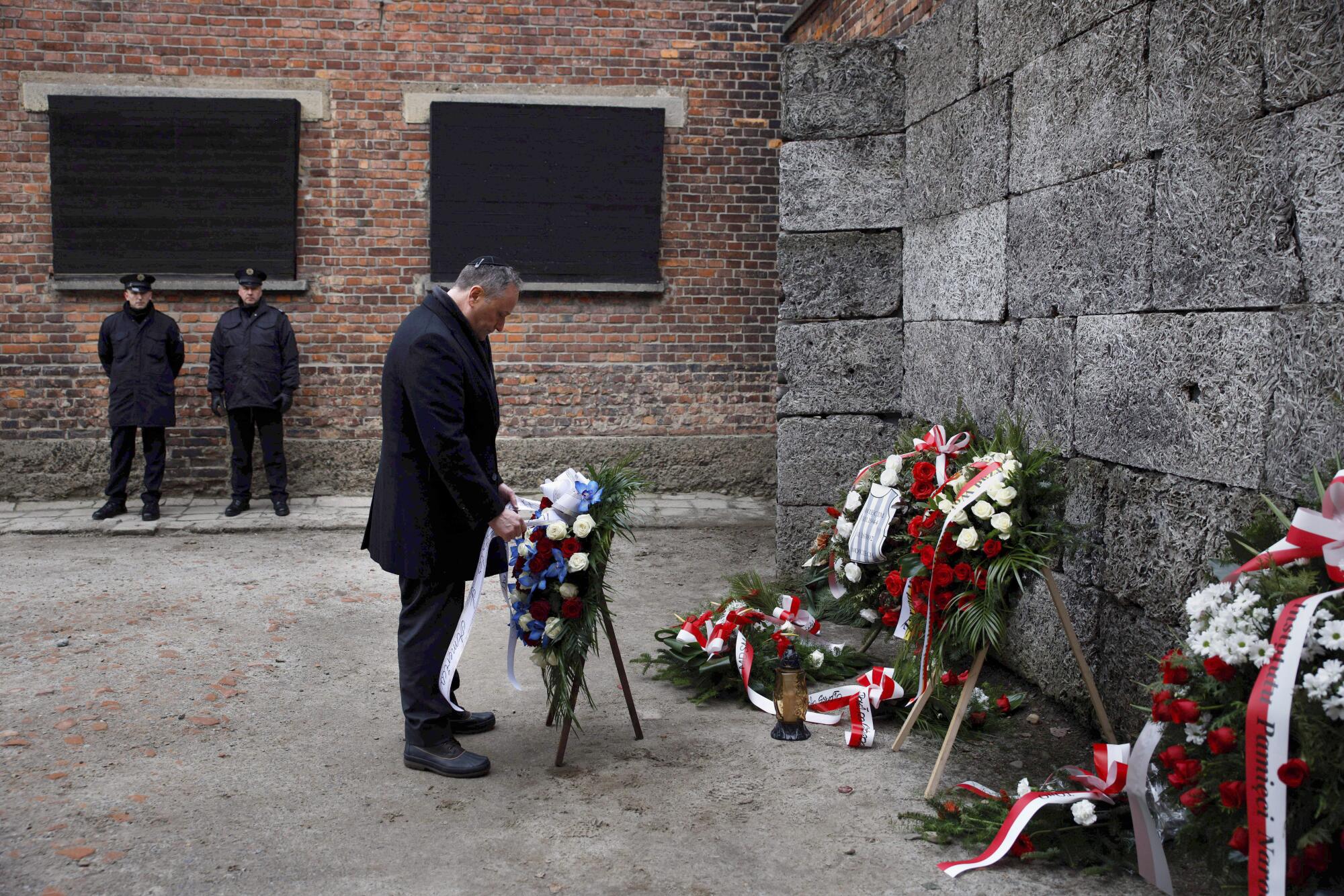
A few days later, Emhoff made the two-hour drive from Krakow to Gorlice, a small town nestled in a Carpathian valley in southeastern Poland. Until the 1940s, more than half of Gorlice’s population was Jewish.
Gorlice is not especially significant for Holocaust remembrance or frequently mentioned by historians.
But Emhoff’s visit was intensely personal: His great-grandmother and great-grandfather lived there before they immigrated to the United States more than a century ago, fleeing persecution.
With the help of a genealogist, Emhoff had traced his roots to the very address in Gorlice where his great-grandparents had once resided. He stood in front of his ancestral home, trying to imagine the life his great-grandparents had built there — and where he would be if they had stayed. Had they been afraid? Did they have any sense of what was coming? What finally made them want to leave?
He waved to the people inside, smiling as he snapped a photo with his phone. They waved back.
Later, he texted the image to his parents, Barbara and Michael; his sister, Jamie; and his brother, Andy. The elder Emhoffs had been following their son’s trip closely from their home in Palm Desert — even reading the White House pool reports he forwarded to them — but were unaware that he would visit Gorlice.
“This is amazing,” Emhoff’s 85-year-old father, a man of few words, texted back. Staying in touch was important: Even though Secret Service agents trailed Emhoff everywhere, his dad still worried about him.
Emhoff’s last stop in Gorlice was on a muddy hill on the edge of town. He clenched his fists as he began to ascend a snow-caked path into the forest. He walked in silence through a Christian cemetery and past tall pine trees. He paused beneath a gate bearing the Star of David, folded his gloved hands together and approached a gray, concrete monument.
No Jews live in Gorlice now. In 1942, the Nazis marched 700 Jews into this forest, shot them and dumped their bodies in a pit. Their remains lie beneath the blocky memorial.
Christians often leave flowers at graves. But Jews leave stones.
Emhoff reached into the pocket of his overcoat, pulled out a stone and placed it at the foot of the monument.
He raised his gaze, looking beyond the trees that surrounded him, and inhaled deeply. Then he turned around and walked back into the forest.
More to Read
Sign up for This Evening's Big Stories
Catch up on the day with the 7 biggest L.A. Times stories in your inbox every weekday evening.
You may occasionally receive promotional content from the Los Angeles Times.
